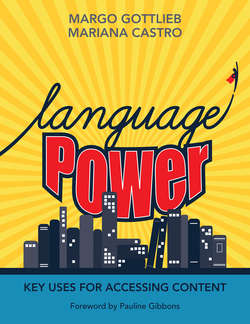Читать книгу Language Power - Margo Gottlieb - Страница 34
На сайте Литреса книга снята с продажи.
Academic Language in Key Uses
ОглавлениеFor many, academic language is synonymous with academic vocabulary. As we suggested in our opening remarks about key uses, our vision of academic language use begins with disciplinary discourse that allows us to think deeply. The power of academic language does not reside in the particular words used but in the ways language portrays knowledge, the identities it confers on those who use it, and its power in connecting current knowledge to more complex ideas, concepts, and understandings. A functional approach to language learning means that the focus is, first and foremost, on the purpose for language use and how the language is shaped by factors in context. Figure 1.4 identifies some of the factors that impact language use in academic contexts.
Be advised: These factors do not work independently but interact with each other and work together to create unique situations and conditions for language use.
1 Topics: The topics are content bound; meaning is drawn from one or more disciplines and their related standards.
2 Purpose: Guided by the academic content standards, the topic, and their associated language, the overall purpose for academic language generally corresponds to DARE, or key uses.
3 Activities: Activities refer to the tasks or actions in which students engage when interacting with new ideas, knowledge, or content.
4 Roles and Stances: Students assume many identities in schools. Sometimes students listen to information from other, more knowledgeable experts, and at times, we ask them to be the more knowledgeable experts. Sometimes, we ask them to cocreate new knowledge with others, and sometimes, we ask them to seek information from other sources.
5 Modalities: By approaching communication through multiple modalities—orally, visually, tactilely, and/or in writing—students have unique opportunities for language use.
6 Audiences: The people involved in the communication influence the way the message is conveyed. The way students use language with peers, for example, is different from the way they use language with teachers. Thus, different audiences require different registers or degrees of formality.
Figure 1.4 Factors That Shape the Context for Communication
Take the DARE
How might you describe the context of communication in your school? Which factors mentioned in Figure 1.4 are taken into account in teaching and learning? Are there any unique factors that must considered for ELLs, long-term language learners, or students with disabilities? Do members of the school community engage in explicit conversations about the culture of the school? What are some spaces or structures that facilitate or have the potential of facilitating these conversations among students, teachers, and school leaders?
Use Resource 1.1 to gain insight into the potential of academic language use during instructional planning. This tool can also be considered as a springboard for conversations with grade-level teams or as a means to compare the variety of contexts in which your students learn. Don’t forget that the icon of the two puzzle pieces coming together signifies that a blank template has been included at the end of the chapter for your personal use.
Resource 1.1 Factors Impacting Language Use in Academic Contexts
Use this tool to reflect and discuss with others the various factors impacting academic language use during teaching and learning.
